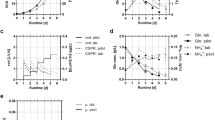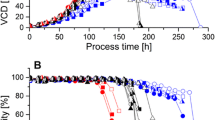Abstract
Scale-down models are indispensable and crucial tools for process understanding and continuous process improvement in product life-cycle management. In this study, a scale-down model representing commercial-scale cell culture process of adalimumab biosimilar HS016 was first developed based on constant power per volume (P/V) principle and then qualified by multivariate data analysis (MVDA) and equivalence test method. The trajectories of the bench-scale process lie in the middle of the control range of large-scale process, built by multivariate evolution model based on nutrients, metabolites, and process performance datasets. This indicates that the small-scale process performance is comparable with that of the full-scale process. The final product titer, integrated viable cell density (iVCD), viability, aggregates, acid peak content, total afucosylation level, and high mannose content recognized as key process attributes (KPAs) or critical quality attributes (CQAs) were equivalent across the scales upon comparison using equivalence test method. The qualified scale-down model was then used for process characterization using a definitive screening design (DSD) where five independent variables including pH, shifted temperature, inoculation seeding density, viable cell density (VCD) at first feeding, VCD at temperature shift were evaluated. Three quadratic polynomial models for final product titer, aggregation, and high mannose were then established using the DSD results. The design space was finally developed using a probability-based Monte Carlo simulation method and was verified with the operation setpoint and worst-case condition. The case study presented in this report shows a feasible roadmap for cell culture process characterization.







Similar content being viewed by others
References
ICH Q8 (R2). Pharmaceutical development. 2009. http://www.ich.org/products/guidelines/quality /article/quality-guidelines.html. Accessed 23 Feb 2019.
Hakemeyer C, McKnight N, St John R, Meier S, Trexler-Schmidt M, Kelley B, et al. Process characterization and design space definition. Biologicals. 2016;44(5):306–18. https://doi.org/10.1016/j.biologicals.2016.06.004.
ICH Q11. Pharmaceutical quality system. 2012. http://www.ich.org/products/guidelines/ quality/article/quality-guidelines.html. Accessed 23 Feb 2019.
Amadeo I, Mauro L, Orti E, Forno G. Establishment of a design space for biopharmaceutical purification processes using DoE. Methods Mol Biol. 2014;1129:11–27. https://doi.org/10.1007/978-1-62703-977-2_2.
Li F, Hashimura Y, Pendleton R, Harms J, Collins E, Lee B. A systematic approach for scale-down model development and characterization of commercial cell culture processes. Biotechnol Prog. 2006;22(3):696–703. https://doi.org/10.1021/bp0504041.
DiCesare C, Yu M, Yin J, Zhou W, Hwang C, Tengtrakool J, et al. Development, qualification, and application of a bioreactor scale-down process: modeling large-scale microcarrier perfusion cell culture. BioProcess Int. 2016;14(1):18–29.
Tescione L, Lambropoulos J, Paranandi MR, Makagiansar H, Ryll T. Application of bioreactor design principles and multivariate analysis for development of cell culture scale down models. Biotechnol Bioeng. 2015;112(1):84–97. https://doi.org/10.1002/bit.25330.
Tsang VL, Wang AX, Yusuf-Makagiansar H, Ryll T. Development of a scale down cell culture model using multivariate analysis as a qualification tool. Biotechnol Prog. 2014;30(1):152–60. https://doi.org/10.1002/btpr.1819.
Schuirmann DJ. A comparison of the two one-sided tests procedure and the power approach for assessing the equivalence of average bioavailability. J Pharmacokinet Biopharm. 1987;15(6):657–80. https://doi.org/10.1007/BF01068419.
US FDA. Statistical approaches to establishing bioequivalence. 2001. https://www.fda.gov/ downloads/drugs/guidances/ucm070244.pdf. Accessed 23 Feb 2019.
Tsong Y, Dong X, Shen M. Development of statistical methods for analytical similarity assessment. J Biopharm Stat. 2017;27(2):197–205. https://doi.org/10.1080/10543406.2016.1272606.
Rathore AS, Pathak M, Jain R, Jadaun GPS. Monitoring quality of biotherapeutic products using multivariate data analysis. AAPS J. 2016;18(4):793–800. https://doi.org/10.1208/s12248-016-9908-z.
Horvath B, Mun M, Laird MW. Characterization of a monoclonal antibody cell culture production process using a quality by design approach. Mol Biotechnol. 2010;45(3):203–6. https://doi.org/10.1007/s12033-010-9267-4.
Jones B, Nachtsheim CJ. A class of three-level designs for definitive screening in the presence of second-order effects. J Qual Technol. 2011;43(1):1–15. https://doi.org/10.1080/00224065.2011.11917841.
Jones B, Nachtsheim CJ. Definitive screening designs with added two-level categorical factors. J Qual Technol. 2013;45(2):121–9. https://doi.org/10.1080/00224065.2013.11917921.
Tai M, Ly A, Leung I, Nayar G. Efficient high-throughput biological process characterization: definitive screening design with the ambr250 bioreactor system. Biotechnol Prog. 2015;31(5):1388–95. https://doi.org/10.1002/btpr.2142.
Erler A, de Mas N, Ramsey P, Henderson G. Efficient biological process characterization by definitive-screening designs: the formaldehyde treatment of a therapeutic protein as a case study. Biotechnol Lett. 2013;35(3):323–9. https://doi.org/10.1007/s10529-012-1089-y.
Herzer S, Bhangale A, Barker G, Chowdhary I, Conover M, O’Mara BW, et al. Development and scale-up of the recovery and purification of a domain antibody Fc fusion protein-comparison of a two and three-step approach. Biotechnol Bioeng. 2015;112(7):1417–28. https://doi.org/10.1002/bit.25561.
Pan X, Streefland M, Dalm C, Wijffels RH, Martens DE. Selection of chemically defined media for CHO cell fed-batch culture processes. Cytotechnology. 2017;69(1):39–56. https://doi.org/10.1007/s10616-016-0036-5.
Bailey JE, Ollis DF. Biochemical engineering fundamentals. 2nd ed. New York: McGraw-Hill College; 1986.
Ju LK, Chase GG. Improved scale-up strategies of bioreactors. Bioprocess Eng. 1992;8(1):49–53. https://doi.org/10.1007/bf00369263.
Burdick RK, LeBlond DJ, Pfahler LB, Quiroz J, Sidor L, Vukovinsky K, et al. Statistical applications for chemistry, manufacturing and controls (CMC) in the pharmaceutical industry. New York: Springer international publishing; 2017.
Fidaleo M, Lavecchia R, Petrucci E, Zuorro A. Application of a novel definitive screening design to decolorization of an azo dye on boron-doped diamond electrodes. Int J Environ Sci Technol (Tehran). 2016;13(3):1735–472. https://doi.org/10.1007/s13762-016-0933-3.
CMC BiotechWorking Group. A-Mab Case Study. 2009. http://www.casss.org/associations/9165/ files/A-Mab Case Study Version 2-1.pdf. Accessed 23 Feb 2019.
Ratanji KD, Derrick JP, Dearman RJ, Kimber I. Immunogenicity of therapeutic proteins: influence of aggregation. J Immunotoxicol. 2014;11(2):99–109. https://doi.org/10.3109/1547691X.2013.821564.
Shields RL, Lai J, Keck R, O’Connell LY, Hong K, Meng YG, et al. Lack of fucose on human IgG1 N-linked oligosaccharide improves binding to human Fcgamma RIII and antibody-dependent cellular toxicity. J Biol Chem. 2002;277(30):26733–40. https://doi.org/10.1074/jbc.M202069200.
Yu M, Brown D, Reed C, Chung S, Lutman J, Stefanich E, et al. Production, characterization, and pharmacokinetic properties of antibodies with N-linked mannose-5 glycans. mAbs. 2012;4(4):475–87. https://doi.org/10.4161/mabs.20737.
Levin AD, Wildenberg ME, van den Brink GR. Mechanism of action of anti-TNF therapy in inflammatory bowel disease. J Crohns Colitis. 2016;10(8):989–97. https://doi.org/10.1093/ecco-jcc/jjw053.
Acknowledgments
The authors would like to thank Dr. Khursheed Anwer from Celsion Corporation for manuscript review.
Funding
This study was supported by National Science and Technology Major Projects for “Major New Drugs Innovation and Development” (Grant No. 2018ZX09736008) and Science Program of Zhejiang province, China (Grant No. 2017C03003).
Author information
Authors and Affiliations
Corresponding authors
Additional information
Publisher’s Note
Springer Nature remains neutral with regard to jurisdictional claims in published maps and institutional affiliations.
Rights and permissions
About this article
Cite this article
Nie, L., Gao, D., Jiang, H. et al. Development and Qualification of a Scale-Down Mammalian Cell Culture Model and Application in Design Space Development by Definitive Screening Design. AAPS PharmSciTech 20, 246 (2019). https://doi.org/10.1208/s12249-019-1451-7
Received:
Accepted:
Published:
DOI: https://doi.org/10.1208/s12249-019-1451-7




